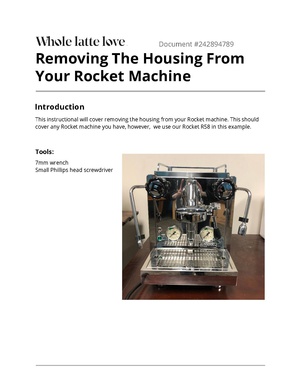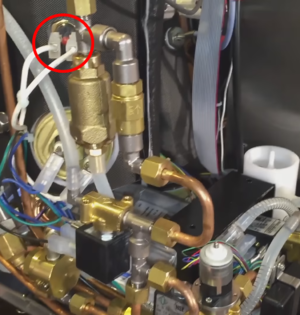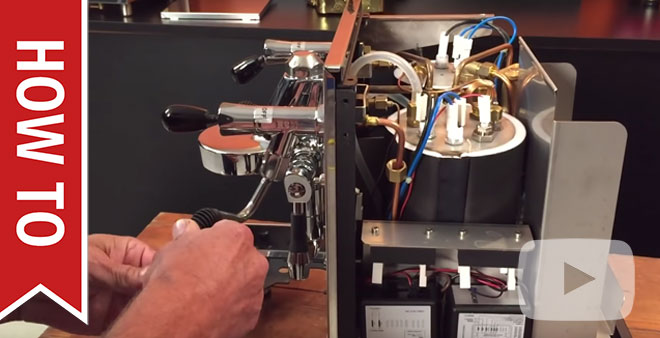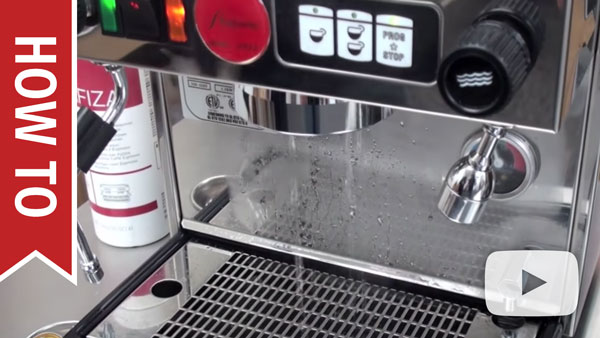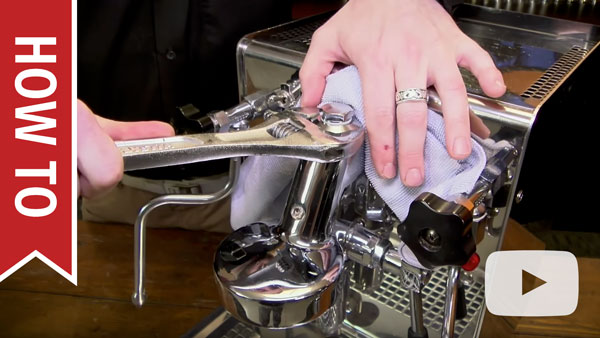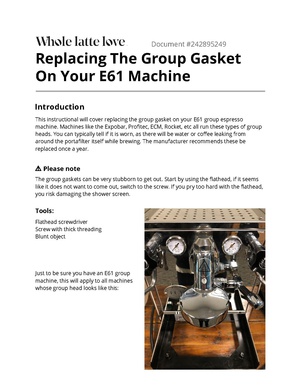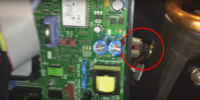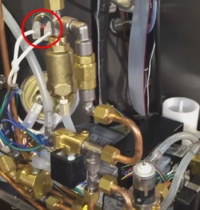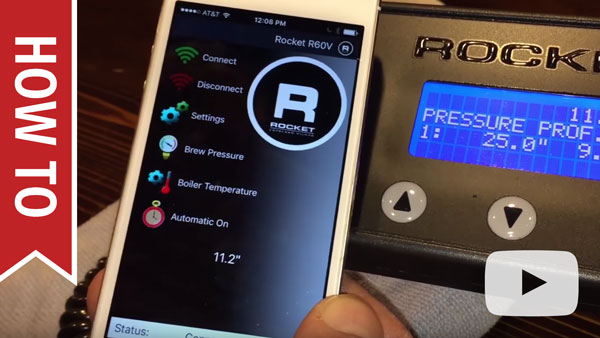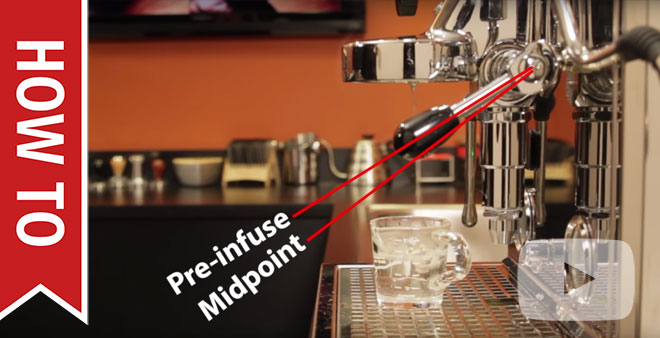Rocket Espresso R 60V/troubleshooting
From Whole Latte Love Support Library
Removing the Housing on Your Machine
Sometimes while troubleshooting, it can be necessary to go inside your machine, whether to inspect for an unfamiliar noise, an ever elusive leak, or just for routine maintenance. You won't need to remove the housing of your machine for every scenario, but these instructions will come in handy in case you find yourself in a situation where you do. If you don't feel comfortable working inside of your machine, feel free to contact a member of our technical support team for further assistance.
Flow Issues
The first place to start with any flow issue is cleaning the machine. Before going through these steps please make sure the machine is cleaned according to the Cleaning and Maintenance Page.
No Steam From Wand
- Check the brew function on the machine and see if water is able to flow through the machine for this function.
- If the brew water is not flowing either refer to the No Flow At All section of this article
- If the brew water flows but is not hot refer to the On But Not Heating section of this article.
- Check the hot water function of the machine. If you are able to draw hot water then the steam boiler must be pressurizing and heating, because hot water is expelled from the machine by steam pressure.
- Check the steam gauge of the machine. Does it show pressure? Typical range for the steam gauge should be 1-1.2 Bar.
- First unplug the machine, let it cool off, and then remove the casing.
- The high limit switch can be found on the steam boiler on the right hand side of the machine once the casing is removed.
- To reset the high limit switch press on the red reset button in the center of the high limit switch several times.
High Limit Reset Instructions
- If the gauge is within the 1-1.2 Bar range then the steam wand is likely blocked.
- Remove the tip from the steam wand and test the flow. If flow is restored then the tip needs to be cleaned and reattached.
- If the flow is still blocked then there may be a blockage in the steam wand itself. Clean the wand by using a pipe brush that has synthetic or plastic bristles; metal bristles can damage the wand. Then soak the wand in a solution of hot water and backflushing powder for ten minutes. Test flow again.
- If there still isn't flow then there may be a blockage farther back in the steam circuit. The machine may need to be professionally cleaned to remove the blockage.
- If the gauge is not reaching 1-1.2 Bar, but it is pressurizing some, then the steam temperature setting on the PID may need to be adjusted. Instructions for changing the PID settings can be found in the section of this article that discusses programming the PID.
- If the gauge is sitting at zero then the steam boiler is not building pressure for some reason.
- If the machine is spewing a lot of steam from the top as it is heating up then the vacuum relief valve may be stuck open. This valve is supposed to close once the machine produces enough steam pressure.
- The high limit switch may be tripped. The high limit switch is an internal killswitch which prevents damage to the machine caused by power surges or the machine overheating.
Poor Or No Flow From Grouphead
If the steam/hot water for the machine is working fine then there is likely something causing a blockage or pressure issue in the brew circuit. Otherwise refer to the section of this article that discusses the machine not flowing at all.
- If a water softener is attached to the inlet line of the machine, it may be preventing water from flowing. Please remove the softener and see if the flow improves.
- The grouphead is dirty and needs to be cleaned.
- Taking apart the grouphead for manual cleaning is the first step. This should be done on a monthly basis. The instructions can be found here.
- If cleaning the grouphead restores flow to the grouphead, the machine should be immediately backflushed to prevent further flow issues.
- There might be a kinked, broken, or loose line somewhere in the machine. Remove the top of the machine and take a look inside to see if you see any obvious issues.
- There might be an issue with one of the internal valve assemblies, which may need to be cleaned or replaced.
No Hot Water From Wand
- Check the brew function on the machine and see if water is able to flow through the machine for this function.
- If the brew water is not flowing either refer to the No Flow At All section of this article
- If the brew water flows but is not hot refer to the On But Not Heating section of this article.
- Check the steam function of the machine. If you are able to steam then the hot water circuit must be heating and pressuring, since these functions share the same boiler, and hot water is expelled by steam pressure.
- Check the steam gauge of the machine. Does it show pressure? Typical range for the steam gauge should be 1-1.2 Bar.
- If the gauge is within the 1-1.2 Bar range then the hot water wand is likely blocked.
- Remove the tip from the hot water wand and test the flow. If flow is restored then the tip needs to be cleaned and reattached.
- If the flow is still blocked then there may be a blockage in the hot water wand itself. Clean the wand by using a pipe brush that has synthetic or plastic bristles; metal bristles can damage the wand. Then soak the wand in a solution of hot water and backflushing powder for ten minutes. Test flow again.
- If there still isn't flow then there may be a blockage farther back in the steam circuit. The machine may need to be professionally cleaned to remove the blockage.
- If the gauge is within the 1-1.2 Bar range then the hot water wand is likely blocked.
- If the gauge is not reaching 1-1.2 Bar, but it is pressurizing some, then the steam temperature setting on the PID may need to be adjusted. Instructions for changing the PID settings can be found in the section of this article that discusses programming the PID.
- If the gauge is sitting at zero then the steam boiler is not building pressure for some reason.
- If the machine is spewing a lot of steam from the top as it is heating up then the vacuum relief valve may be stuck open. This valve is supposed to close once the machine produces enough steam pressure.
- The high limit switch may be tripped. The high limit switch is an internal killswitch which prevents damage to the machine caused by power surges or the machine overheating.
- First unplug the machine, let it cool off, and then remove the casing.
- The high limit switch can be found on the steam boiler on the right hand side of the machine once the casing is removed.
- To reset the high limit switch press on the red reset button in the center of the high limit switch several times.
No Flow At All
If the machine is set to the plumbed mode:
- First try switching to the reservoir mode temporarily and see if it resolves the issue. If this resolves the flow issue, then the issue is specific to the inlet plumb line, and you should go to the next step. Otherwise keep the machine in reservoir mode and skip down to the next section which deals with testing the "No Flow" issue for the machine in reservoir mode.
- Return the machine to plumb mode. The next thing to check is to see if we can isolate where the flow issue is occurring for the plumb line. Try putting the plumb line hosing into an external bucket or container filled with water and see if the machine will draw water from this source. If it can't, then there may be a blockage somewhere in the plumb line itself.
- If you are able to draw water from the plumb line, then there may be an issue with the plumbing supplying this line.
If the machine is set to use the reservoir:
- If the pump does not sound like it is activating:
- Check to make sure the water tank is filled, and the machine isn't indicating that the water tank is empty.
- If the tank is empty, refill it.
- If the tank is full, but the machine thinks the water tank is empty then the tank may not be seated correctly. Make sure there isn't anything blocking the tank from sitting flush inside the machine.
- Remove the cover of the machine and check for any loose or disconnected wires.
- Make sure there aren't any kinked or pinched hoses.
- There may be an issue with the water tank sensor. The tank's level sensor is not compatible with reverse osmosis or zero waters because of their lack of mineral content. The sensor depends on minerals being in the water to pass an electrical signal which tells the machine that water is present in the tank. Waters that don't have enough mineral content will not be able to pass this electrical signal, so the machine will not think water is present.
- There may be an issue with the pump powering on.
- If the pump does sound like it is activating:
- Check the water tank to make sure it is filled, sitting flush, and properly inserted into the socket.
- Open up the machine. Make sure there aren't any kinked or pinched hoses anywhere.
- There may be a stuck valve inside the machine.
Machine Is Leaking
Between Portafilter & Grouphead
If the machine is leaking from between the grouphead and the portafilter then the grouphead gasket is either pushed out of place and needs to be reinserted properly, or the gasket is worn out. Typically, grouphead gaskets will wear out in approximately 6 months to a year depending on how heavily the machine is used. Premature wear to this gasket can be caused by using excessive force when attaching the portafilter. It is important to distinguish where the leaking is occurring. If the leaking is originating from farther up on the grouphead assembly and then draining down to where the portafilter is attached, then refer to the section of this article which discusses leaking from the grouphead.
If the leaking is coming from between the portafilter and grouphead where you twist the handle on, then the gasket will need to be replaced. Instructions for replacing the gasket can be found in this document. You can try using the instructions to clean and reseat the current gasket. If that does not resolve the leak then the gasket will need to be replaced.
The gasket can get stuck in the grouphead from wear or excessive heat exposure. To remove the gasket take some self-tapping screws and partially screw them into the group gasket. Make sure not to go all the way through the gasket because you can scratch/dent the grouphead if you go too far. Then use a pair of pliers to pull on the screws and the gasket will pull out with them.
From The Grouphead
There may be a broken or dirty o-ring or valve inside the grouphead assembly. Instructions for cleaning an E-61 style grouphead can be found here.
From Bottom Of Machine
- Check the water tank and drip tray to make sure there are no cracks or breaks where water can escape. Make sure they are properly positioned on the machine.
- Open the machine and check all of the connections to make sure they are securely attached.
- Examine the pump and boiler assemblies to see if there are any cracks in them. If the machine was exposed to subfreezing conditions without being properly drained it can cause these components to crack. These parts will need to be replaced if they are cracked.
- Make sure both the inlet line and the outlet line on the pump are securely connected.
- Check the various valves located on top of the boiler assembly.
- If water is leaking from the relief valves, then the boiler may be overfilling. Distilled, reverse osmosis, and zero water are not compatible with this style of machine as the water level probe depends on minerals in the water to detect its presence. These water types do not contain minerals, and so the machine will continuously fill until it overflows, usually resulting in water leaking from the relief valves.
- If water is leaking from the relief valves even though you are using a water that contains minerals, then you may need to clean the water level probe.
- If the machine is plumbed, then there may be too much pressure at the inlet line. The pressure restrictor may need to be adjusted, or if you do not have a pressure restrictor installed you may need to install one.
- If the valves are leaking directly from where they screw into the boiler, then they may have a broken seal. Try resealing the valves by using white teflon plumbers tape or food safe permabond and screwing them back into the boiler.
- If there are any broken or cracked hoses, or hoses with pinhole leaks, they will need to be replaced.
- If your machine features drain plumbing, make sure the drain line is securely attached and that water is being correctly directed into the drain cup.
- If you cannot find the source of the leak, it's possible the water you are seeing is from water spilled when refilling the machine, or from the drip tray being out of position. It is also possible to run the unit with the casing off to help identify the source of the leak; precautions should be taken to protect yourself from any exposed wiring or hot water or steam that comes from the machine if you attempt this.
Steam From Top Of Machine
If there is steam coming from the top of the machine then one of the relief valves is venting steam.
- If the steam is leaking from the machine while it is heating up, with more and more steam coming from the top as the machine heats more, then the steam is coming from the vacuum relief valve.
- The vacuum relief valve is meant to vent steam until a certain amount of pressure has built up in the boiler. It is normal for this valve to vent steam as the machine is heating. Once enough steam pressure is built up in the boiler the valve will pop closed.
- If the machine is fully heated and the vacuum relief valve is still not closing then it may need to be cleaned.
- If cleaning the vacuum relief valve has not resolved the issue, then the vacuum relief valve may be broken and will need to be replaced.
- If the steam is leaking from the machine after it is fully heated, then the pressure relief valve may be relieving excess steam pressure.
- The steam boiler temperature may need to be lowered. If your machine features a pressure gauge it should not read any higher than 1.2 bar. Program the steam boiler temperature lower and lower until the relief valve stops opening and the pressure gauge reads 1.2 bar or lower.
- If lowering the temperature is not helping, then the pressure relief valve may be stuck open.
From Steam Wand Or Hot Water Tap
- If either wand is leaking from the end of the wand, it means the steam/hot water valve is not fully closed.
- Make sure the knob is securely in the closed position.
- If the knob feels loose, or doesn't appear to be properly engaging, then there may be a loose or broken part in the knob assembly.
- If the leaking persists, then the corresponding valve may need to be replaced.
- If the wand is leaking between the tip and the arm of the wand during use, there is an o-ring that is broken, missing, or out of position.
- If the wand is leaking from the ball joint, then there may an o-ring that is worn out or out of position.
Machine Not Heating Or Powering On
No Power
- Make sure the machine is plugged into an appropriate power source.
- Do not use the machine on a surge protector. This machine has a high power draw, more than a typical kitchen appliance such as a refrigerator or a microwave. Surge protectors are typically not rated to handle the amperage this machine requires.
- Try using the machine on a different outlet, and make sure the machine is the only appliance plugged into that outlet.
- Make sure the power switches are functioning properly and not broken. If the machine isn't powering on try pressing and holding the power button in the on position to see if the machine turns on. If you are able to power the machine on this way then the power switch needs to be replaced.
- If the machine recently had a leak, had water spilled on it, or any other exposure to moisture then the machine may be shorting out. Try letting the machine sit unplugged for 48 hours to make sure there isn't a short caused by moisture.
Brew Not Heating
- Give the machine sufficient time to heat up. A heating time of 20-30 minutes is recommended for prosumer style machines for it to be sufficiently heated for brewing. Make sure the portafilter is attached during heating.
- Make sure the heating indicator is on. If the heating indicator is not on, then the machine will not heat. Typically this light will be off if the machine is out of water or not able to fill the boiler.
- Make sure the brew temperature is programmed to an acceptable temperature. Optimum temperature for brewing is between 195-205 F°. Make sure the PID is programmed to a temperature in this range. Instructions on how to adjust the PID can be found in the section of this article that discusses [#Adjusting The PID adjusting the PID].
- The high limit switch may be tripped and needs to be reset.
- First unplug the machine, let it cool off, and then remove the casing.
- The high limit switch can be found on the brew boiler on the left hand side of the machine once the casing is removed, behind the control board.
- To reset the high limit switch press on the red reset button in the center of the high limit switch several times.
- The heating element may be broken and may require replacement.
Steam Not Heating
- If the machine is producing steam, but you think it's not producing enough steam, make sure that you are purging the line before frothing. To purge the line simply open the steam knob and let steam come through until it changes from mostly water to mostly steam. When steam leaves the boiler and hits the cold wand it is going to condense back into water. If you do not purge the line it will affect the way the steam wand froths.
- Make sure the steam boiler is turned on for the machine. Most prosumer units feature a switch, button, or PID menu option to turn the steam boiler off.
- Give the machine sufficient time to heat up. A heating time of 20-30 minutes is recommended for prosumer style machines for it to be sufficiently heated for brewing. Make sure the portafilter is attached during heating.
- Make sure the heating indicator is on. If the heating indicator is not on, then the machine will not heat. Typically this light will be off if the machine is out of water or not able to fill the boiler.
- Make sure the steam temperature is programmed to an acceptable temperature. Instructions on how to adjust the PID can be found in the section of this article that discusses [#Adjusting The PID adjusting the PID].
- The high limit switch may be tripped and needs to be reset.
- First unplug the machine, let it cool off, and then remove the casing.
- The high limit switch can be found on the steam boiler on the right hand side of the machine once the casing is removed.
- To reset the high limit switch press on the red reset button in the center of the high limit switch several times.
- The high limit switch is circled in red; the red button in the center is the reset.
- The heating element may be broken and may require replacement.
On But Not Heating
The tank's level sensor is not compatible with reverse osmosis or zero waters because of their lack of mineral content. The sensor depends on minerals being in the water to pass an electrical signal which tells the machine that water is present in the tank. Waters that don't have enough mineral content will not be able to pass this electrical signal, so the machine will not think water is present, and will not heat as a result.
- If your machine is running off of the reservoir, make sure it is filled with water. Don't use distilled or reverse osmosis water, as the boilers rely on some minerals to detect water level.
- Make sure both the steam and the brew boilers are turned on. Most prosumer machines allow for individuals boilers to be turned off for energy efficiency.
- The steam boiler takes priority. If the steam boiler isn't heating for some reason, the brew boiler won't heat. Try turning the steam boiler off and see if the brew boiler starts heating.
- There is a loose, disconnected, or broken wire inside the machine. Remove the top of the machine and inspect the wiring.
- The high limit switch of the machine may have tripped.
- First unplug the machine, let it cool off, and then remove the casing.
- There are two high limit switches in the machine. The steam high limit switch can be found on the steam boiler on the right hand side of the machine.
- The brew high limit switch can be found on the brew boiler on the left hand side of the machine, behind the control board.
- To reset the high limit switches press on the red reset button in the center of the high limit switch several times.
- The outlet the machine is plugged into is not rated to handle the power draw of the machine.
- In very rare cases both heating elements will have broken simultaneously. This will happen only if the machine is exposed to a severe power surge.
Adjusting The PID
The machine can be programmed through the smartphone app like shown in the previous section, but it can also be programmed directly through the PID.
Portafilter Handle Not Fitting On Machine
- On all new machines, the portafilter may or may not fit perpendicular to the machine. This is perfectly normal. This is because the grouphead gasket requires time to wear in before this can happen. As long as you can get the portafilter hand tight onto the machine and brew without leaking, then the machine is operating properly.
- Too much coffee may be dosed into the portafilter. If there is too much coffee in the portafilter, it can press into the shower screen and prevent the portafilter tightening all the way. Reduce the amount of coffee in the portafilter and try again. If you see an indentation from the shower screen in the grounds, then you’ve added too much.
- Check the filter baskets for dings, dents, or any sort of warping. A filter basket that is malformed can prevent the filter basket from sealing up against the group gasket.
- The group gasket has slipped out of place or needs replacing. Please refer to the section of this article which discusses gasket issues for instructions on how to test the gasket or replace it.
What is Preinfusion?
Pre-infusion is what allows a small amount of water through first, before beginning the shot. It allows this water to saturate the coffee and get the grounds equally wet. This can make the coffee extract more smoothly. Water will always take the path of least resistance. By letting the water saturate the grinds before brewing at 9 bars of pressure, this can help prevent channeling.

